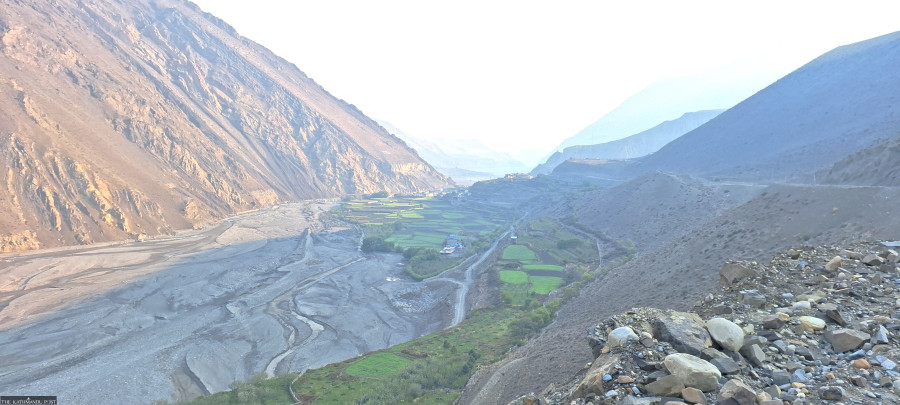Climate & Environment
Climate change hits mountain people on multiple fronts
Past rain shadow regions of Manang and Mustang are seeing heavy rains, falling crop yields, and destruction of homes in recent years.
Basant Pratap Singh
Nisha Tulachan, an 18-year-old woman from Mustang’s Naurikot, died in her sleep. Her house made up of mud collapsed on her on the night of July 26, 2020 and she died on the spot. Her 70-year-old grandfather was seriously injured. Tulachan’s uncle Shukra Gauchan said that it had been raining for two days before the night of the incident, and their traditional house made of wood, hay, stones, and mud gave in.
“There are 28 houses in Naurikot, all built in the traditional style as ours. Rains are unusual in the mountains, so the whole village was shocked,” said Gauchan. Residents of Naurikot who were living in houses with traditional mud roofs, started demolishing and building concrete houses after the incident. Naurikot village lies at an altitude of 2,740 metres in ward 2 of Thasang Rural Municipality, in Mustang.
“In the mountain region, traditional mud houses are the best for staying warm, but when rains started becoming more frequent, everybody got scared. People from several other wards of the rural municipality also started building new houses by demolishing the old ones,” Gauchan added.
Lo Manthang, which lies at an altitude of 3,840 meters above sea level, is the northernmost settlement in Mustang. The residents of Lo Manthang are also building concrete houses by demolishing traditional mud houses.
Prem Hinjing Gurung, a 66-year-old man from Lo Manthang in ward 5 of Lo Manthang Rural Municipality, said that more than 25 houses in the village have been built with concrete now. “Those who could afford, built new concrete houses, and a few families migrated elsewhere,” said Gurung.
The statistics of the National Disaster Risk Reduction and Management Authority (NDRRMA) also show that heavy rains in Mustang district have started causing extensive damage.
According to the NDRRMA website, two houses were completely destroyed due to the heavy rains in the fiscal year 2017-2018, and property worth Rs15.6 million was lost.
In 2005, climate change and environment expert Ngamindra Dahal wrote in the Tiempo magazine of the University of East Anglia in the UK that the livelihoods of the locals were being affected when abnormal rains started in the high Himalayan regions like Mustang.
Later in 2011, Dahal started further research on climate change in the mountain region. The residents of Mustang and Manang districts told him that their areas were seeing abnormal climate patterns—unexpected rains in summer and less snow in winter.
Some locals told Dahal that losing traditional houses also meant losing culture and tradition.
Dahal said that due to climate change, monsoon rain, which is generally limited from 2,500-3,000 meters above sea level, is now affecting Mustang and Manang, which are above 3,500 meters.
“South Asian monsoons do not go higher than 2,500 to 3,000 meters, but the monsoon has moved up to 4,000 meters in just the last two or three decades,” said Dahal.
The geography of Mustang and Manang are very different and sensitive. In the mountain region, where there would be no rainfall, people grew crops using the melted snow. The mountain districts across the Himalayas, which had different seasonal cycles, have now become a monsoon region, Dahal further added.
According to a journal article published by Dahal in 2022, the average annual temperature in lower Mustang has increased by 0.021 degrees Celsius per year, and the average annual rainfall has increased by 1.83 millimeters per year in the last 45 years.
The data provided in the journal was similar to the temperature and rainfall data recorded at meteorological stations in the lower Mustang region from 1973 to 2018.
According to the NDRRMA, there have been five instances of heavy rains and avalanches in Mustang and Manang since the fiscal year 2014-2015. Similarly, the two districts saw 32 landslides and 19 incidents of flooding since then.
In Mustang alone, 31 houses were completely destroyed by floods in four places in the last monsoon season. Similarly, 16 houses were partially damaged, and more than 35 families were affected.
The floods on May 28, 2021, and June 15, 2021, damaged property worth Rs3 billion, destroying houses, bridges, schools, and roads, among other infrastructures, in Nason, Chame, and Manang Nesyang rural municipalities of Manang district.
According to the Department of Hydrology and Meteorology, the rainfall measurement station at Humde in Manang recorded 82.2 mm of rain on June 15, 2021.
In Humde, the average rainfall in June 2015 was 42 mm, but in June 2021, the area saw 197 mm of rainfall in a period of 15 days. This was 469 percent more than that of June 2015 average. In May 2021, the area recorded 693 percent more rain compared to the same period in 2015.
The change in the timing of seasonal rainfall has also impacted agriculture in mountain districts.
Farmers in high altitude areas are facing challenges in protecting their crops—they grow mainly potato, wheat, barley and buckwheat—as the temperature increases and the pattern of rain changes.
Aaita Bahadur Thakali, a local farmer from ward 5 of Gharapjhong Rural Municipality, Mustang, reported a decline in crop yields.
According to Karma Gurung from Dhumba in Gharpajhong Rural Municipality, Mustang, who has been involved in commercial cultivation of apples for decades, the district produced 5,464 metric tons of apples on 520 hectares in the fiscal year 2021-2022. Although the apple growing area has expanded to 1,400 hectares, the total production was only 6,250 metric tons in the fiscal year 2023-24.
Madan Regmi, head of the Agriculture Knowledge Centre in Manang, said that on April 26, it snowed in upper Manang damaging the apple flowers. Also, the activity of helpful insects in pollination (bees and bumblebees) was subdued as the temperature was below the freezing point.
“Unexpected weather events, which have become more frequent, during the main season, have hit crop yields badly,” said Regmi.
“Not just apples, but vegetable production has also been affected—by the cold. The lower areas of Manang that used to receive monsoon rains, have been seeing dry monsoons for the past few years. The earlier rain shadow region in the highlands, have been seeing heavy rainfall during the monsoon for the past few years. These unexpected shifts in rain patterns have hit farmers the most,” Regmi added.
Locals say a pine species locally called Sang tree found in the upper Mustang region and used for worship and other rituals, are also disappearing due to climate change.
According to a report published by the National Statistics Office, 47.1 percent of the families in the Himalayan region of Gandaki Province participating in the survey said that they have felt the effects of climate change in the last 25 years.
In the Gandaki province, 39.5 percent of families said that new diseases and insects have appeared in crops over the past 25 years.
Similarly, 97.4 percent families in Gandaki are not aware of the early warning of climate disasters, according to the office’s survey.
The chief district officer of Mustang, Janakraj Panta, who is also the chairman of the District Disaster Management Committee, said that the local governments are working on climate adaptation and risk reduction to the best of their abilities, but these efforts are not enough.
“The situation has gone beyond the control of the local government and the district authorities. The provincial and federal governments are also aware of the climate-induced disasters, but have not been taking mitigation measures,” said Pant. “The more the delay in implementing long-term programmes, the more the likelihood of further damage,” Pant added.
Environment expert Dahal said the federal and provincial governments should take the initiative to implement long-term climate adaptation and disaster mitigation measures.




 9.12°C Kathmandu
9.12°C Kathmandu











